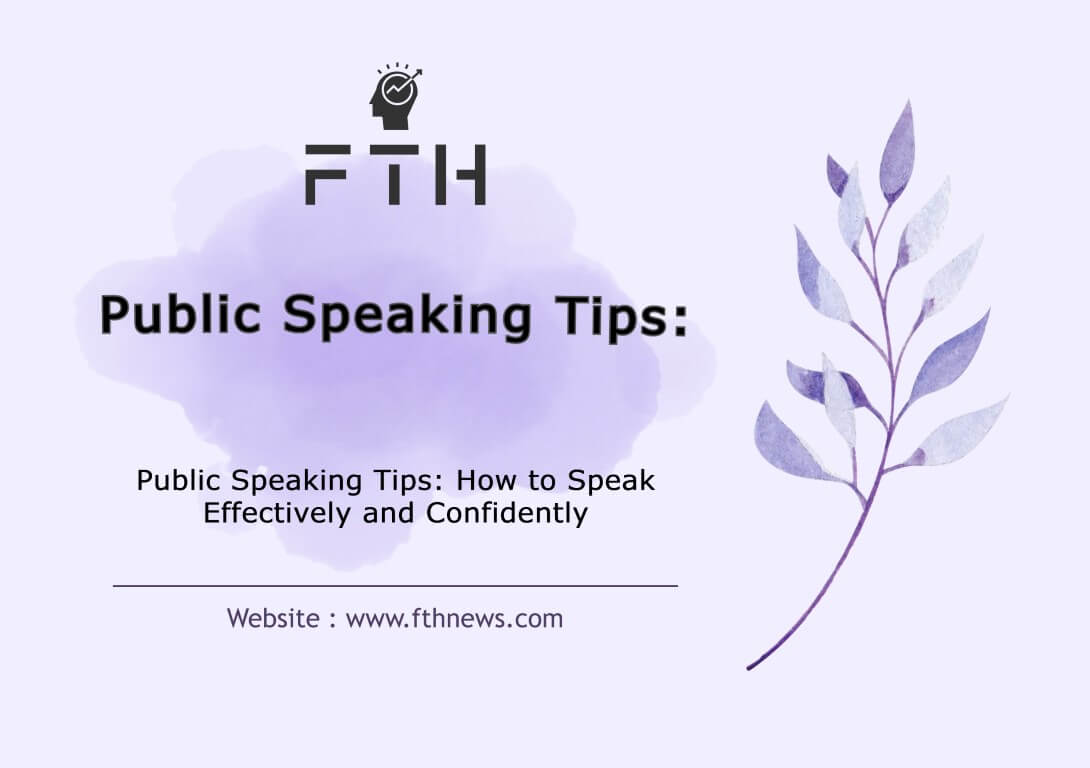
Public Speaking Tips: How to Speak Effectively and Confidently
Public Speaking and Good communication is the key to success.” How many times have you found yourself in a difficult situation because you struggled to articulate your thoughts effectively, got lost in your own words, or felt overshadowed by others’ speaking prowess?
Effective communication isn’t just a personal virtue; it’s a game-changer in both your personal and professional life. In this article, you’ll acquire the knowledge you need to become an eloquent and effective communicator through practice!
Express Your Opinions Decisively in Public Speaking
Before delving into the details, it’s crucial to ensure that you genuinely believe in what you’re about to say. Public Speaking And Effective speaking doesn’t require arrogance or constant approval-seeking; it thrives on authenticity.
Tip: The choice of your words plays a pivotal role. Starting sentences with phrases like “I think…” or “Maybe…” can undermine the impact of your speech, as they convey uncertainty.
Comparison:
❌ I think that in order to improve quality, we should consider using higher-quality raw materials.
✔️ To enhance quality, we must utilize higher-quality raw materials.
Make Eye Contact
Maintaining eye contact is a fundamental aspect of effective and prestigious Public Speaking. It not only captures your audience’s attention but also conveys confidence and clarity in your message.
When Public Speaking to an audience, select a few friendly faces and hold their gaze for 2 to 3 seconds. This practice will not only boost your self but also ensure your message is communicated more distinctly.
Avoid staring at the ground, which can make you appear unsure and hesitant. Similarly, resist the temptation to scan your surroundings while speaking, as it can make you seem disinterested and unfocused.
Helpful Hints:
If you find yourself feeling nervous or uncertain during your speech, don’t immediately assume that your message is unclear . Do not let one individual’s reaction derail your focus.
In situations where making eye contact with every individual in a large crowd is impractical, prioritize making eye contact with several people in the front rows. This will give the impression that you are engaging with the audience as a whole.
Leveraging the Power of Statistics
Utilizing statistics in your speeches can be an incredibly effective and persuasive tool. However, it’s crucial to ensure that the statistics you employ are not only accurate but also presented in a concrete and irrefutable manner.
Dealing with Stress: Practice and Preparation
It’s important to understand that experiencing physiological reactions like heart palpitations and hand tremors during a speech is entirely normal. Blaming yourself or assuming your speech is doomed is not the solution.The best way to overcome anxiety is through thorough practice and preparation. Review your notes diligently and, once you’ve mastered your speech, practice it extensively. Seek constructive criticism from friends or even film yourself to identify areas for improvement.
The Critical First 60 Seconds: Captivating Your Audience
Those initial 60 seconds of your speech are make-or-break moments for capturing your audience’s attention. Miss this window, and you risk losing their interest, perhaps even to the point of inducing drowsiness.However, there’s no need to stress. You can maximize these 60 seconds effectively. Craft an engaging short story, pose a thought-provoking question, or share a startling statistic to pique your audience’s curiosity.
Mastering the Art of the “Pause”
Constantly employing filler sounds like “um” and “oh” can be a significant distraction and a source of audience fatigue. Rather than using these fillers, an adept speaker knows the power of well-timed pauses.A pause allows your audience to digest the previous point and readies you for the next one, enhancing the flow and impact of your speech.
Seek Feedback and Improve Your Craft
Your speech doesn’t end when you’ve said your final words. After concluding your presentation, actively seek feedback from your audience. You can distribute feedback forms or simply engage your listeners in a discussion about their thoughts on your speech.Their input can be invaluable for pinpointing areas that need improvement, thus helping you enhance your public speaking skills.
Know the Environment
Familiarity with your speaking environment is vital to successful communication. Here are some essential tips to ensure you’re well-prepared:
Arrive Early: Arriving ahead of time allows you to acclimate to the surroundings. This time can be used to walk around the area, ensuring you’re comfortable with the layout and setup. It also offers the chance to test any equipment, like microphones or projectors, that you’ll be using during your speech.
Practice with the Equipment: Familiarizing yourself with any audiovisual or presentation aids will help avoid unexpected technical difficulties during your speech.
Know Your Audience: Understanding your audience’s demographics and expectations will help tailor your speech to their interests and needs. This can significantly reduce anxiety and stress associated with public speaking.
By taking these steps, you’ll enter your speaking engagement with confidence, knowing what to expect, and be better equipped to deliver a compelling and effective speech.
Visualize Yourself Giving a Speech
Visualizing your speech is a powerful technique for building confidence and ensuring a successful presentation. Follow these steps to effectively employ this method:
1: Close your eyes and imagine the scenario where you’re about to deliver your speech.
2: Picture yourself standing confidently in front of your audience, speaking with a loud, clear, and self-assured voice.
3: Envision your audience captivated by your words and presentation. Imagine them nodding in agreement and engagement.
By repeatedly visualizing a successful speech, you can build your confidence and reduce performance anxiety.
Tip: On the day of your speech, recall your mental rehearsal. If everything went smoothly in your imagination, there’s no reason it shouldn’t in reality.
Know Your Audience
Understanding your audience is a crucial aspect of effective speaking. It significantly boosts your confidence and enables you to tailor your speech to their needs. Here’s how to get to know your audience:
Demographics: Learn about the age, background, and interests of your audience. This information helps you choose your words, examples, and anecdotes that resonate with them.
Prior Knowledge: Understanding their familiarity with the topic allows you to adjust the level of detail and complexity in your speech. Whether they are experts or beginners, adapting your content accordingly will enhance your credibility.
Cultural and Personal Preferences: If you’re addressing a smaller audience, knowing factors like their political beliefs, sense of humor, and interests can help you connect with them more effectively.
By knowing your audience, you can create a speech that speaks directly to their needs and interests, ultimately boosting your confidence and ensuring your message is well-received.
Body Language Should Show Your Confidence
Your body language plays a significant role in conveying confidence and maintaining discipline during your speech. Here are some tips to ensure your body language exudes confidence:
Maintain Physical Fitness: Being in good physical shape can naturally boost your confidence. Regular exercise and a healthy lifestyle can help you stand tall and feel more assured.
Posture Matters: Avoid hunching or stooping, as these postures can make you appear unsure or lacking in confidence. Stand or sit up straight, projecting a sense of self-assuredness.
Control Hand Movements: Be mindful of your hand gestures. Avoid excessive and sloppy hand movements, which can distract from your message. Use purposeful and controlled gestures to emphasize points.
Limit Excessive Movement: Excessive pacing or wandering around the stage can convey nervousness. Instead, maintain a calm and controlled presence, moving purposefully and sparingly.
Maintain Eye Contact: While you’ve already learned about the importance of eye contact, it’s worth emphasizing here as a crucial aspect of your body language. Keeping eye contact shows your engagement and confidence.
Relaxed Face and Body: Avoid looking tense or anxious. Keep your facial expressions and body relaxed, which will make you appear more composed and self-assured.
Speak Loud Enough for Everyone to Hear in Public Speaking
Effective communication involves speaking clearly and audibly to ensure everyone can understand you. While you shouldn’t shout, it’s essential to project your voice with confidence:
Tip: Avoid speaking too softly, as it can make you seem shy and insecure. Ensure that your voice reaches all corners of the room without straining or shouting.
Caution: Shouting excessively can be off-putting, making it seem like you’re compensating for a lack of compelling content. Balance is key.
Increase Your Vocabulary for Public Speaking
Expanding your vocabulary is a valuable asset for eloquent and effective speaking. To enhance your linguistic skills:
Read Widely: Read a variety of articles, books, and materials to expose yourself to different words, phrases, and writing styles. This will naturally expand your vocabulary.
Contextual Learning: Pay attention to how words are used in context. This will help you understand their nuances and usage more effectively.
Use New Words: Incorporate newly learned words and phrases into your everyday language. Practice is key to retaining and effectively using your expanded vocabulary in your speeches.
By increasing your vocabulary, you not only improve your speaking skills but also enrich the depth and impact of your communication.
Do Not Overdo the Use of Slang in Public Speaking
Balancing the use of slang expressions in your speech is essential for effective communication. While some slang can add a touch of informality and relatability, overuse can hinder understanding and professionalism. Here are some tips:
Tip: If your audience is younger and receptive to informal language, you can adopt a more relaxed tone without becoming overly formal. Adjust your language to match the context and the expectations of your listeners.
Caution: Overusing slang or trendy expressions can make your speech less accessible to a broader audience and potentially diminish your credibility, especially in more formal settings.
Be More Concise
Effective communication often hinges on conciseness and clarity. Knowing what to omit from your speech can make you a more engaging and persuasive speaker. Here’s how to be more concise:
Edit Your Speech: After drafting your speech, edit it for brevity and clarity. Remove any unnecessary examples, repetitions, or overly complex sentences.
Reading Aloud: Read your speech aloud to yourself to identify any redundancies, exaggerations, or convoluted phrasing. This practice helps refine your message.
Comparison:
Overly Wordy: “Achieving and reaching a healthy body weight is the ultimate goal of human existence because it shows the peak of human physical strength, and because of it, self-confidence is strengthened, and a person feels complete.”
Concise: “Attaining a healthy body weight boosts physical strength and overall satisfaction in individuals.”
By being more concise, your message becomes clearer, and your audience is more likely to stay engaged and understand your points more effectively.
Consider a Relaxing Routine for Public Speaking
To manage pre-speech jitters and nervousness effectively, you can implement a calming routine. Here are some strategies to help you maintain composure:
Engage the Audience: Start your speech by addressing an audience member or asking for their opinion. This initial interaction not only allows you to ease into your speech but also provides a moment to calm your nerves.
Strategic Pauses: Incorporate strategic pauses in your speech. Before transitioning to a new topic, take a brief pause, smile, and count to three (one thousand one, one thousand two, one thousand three). This technique helps you regain your composure and maintain control over your nerves.
Channel Nervous Energy: Instead of allowing nerves to overwhelm you, transform that energy into enthusiasm for your speech. Use the adrenaline to fuel your passion and keep your audience engaged.
Favorite Drink: If it helps you relax, consider having your favorite drink before your speech. This can provide a comforting ritual that helps calm your nerves.
Tip: Once you discover a routine that works for you, stick to it and make it a consistent part of your pre-speech preparations.
Don’t Apologize in Public Speaking
Mistakes are a natural part of public speaking, and apologizing for them can draw unnecessary attention to the error. Here’s why you should avoid apologizing for mistakes in your speech:
Tip: Instead of apologizing for a mispronunciation or mistake, simply continue with your speech. In most cases, your audience will quickly move on and forget about the slip-up.
Avoid Self-Deprecation: Phrases like “I’m sorry, friends, I’m so nervous” or “Wow, what a bad mistake” can make the situation more uncomfortable. Self-deprecating remarks can undermine your credibility and professionalism as a speaker.
Embrace Imperfections: Remember that everyone makes mistakes, even seasoned speakers. Embrace these imperfections and focus on delivering valuable content to your audience. The less attention you draw to your mistakes, the more smoothly your speech will flow.
People Want a Successful Public Speaking
Understanding the audience’s expectations is essential for effective communication. Here’s how to approach your speech with a positive mindset:
Positive Thinking: Before you begin your speech, maintain a positive outlook. Remind yourself that your audience wants you to succeed. They are there to listen and gain knowledge from you, not to catch your mistakes.
Audience Expectations: Recognize that your audience expects you to be engaging, motivated, informative, and perhaps even a bit entertaining. They invest their time to learn from you, so focus on delivering a valuable and engaging presentation.
Mistakes Happen: Accept that making occasional mistakes or experiencing moments of confusion is normal in public speaking. The key is how you handle these situations with grace and continue to engage your audience.
Believe in Your Message: Have confidence in the importance of the information you’re sharing. When you genuinely believe in the value of your content, it becomes easier to transmit that conviction to your audience.
By maintaining a positive mindset and focusing on the value you bring to your audience, you’re more likely to become a successful speaker who can engage, motivate, and inform effectively.
The Importance of Starting a Public Speaking
At the outset of your speech, you hold a precious 30 to 60 seconds—the golden window of opportunity. During this time, you can captivate your audience, ensuring their unwavering attention until the very end. This initial phase is not to be underestimated; it serves as a barometer of your credibility and the audience’s willingness to follow your message throughout the speech.
Failure to seize this moment can lead to frustration, disappointment, and disinterest among your listeners. They might begin searching for more engaging distractions on their mobile devices, diverting their attention away from your speech.
Essentially, as a speaker, your ability to connect your speech’s topic with the interests, needs, and preferences of your audience is paramount. If you miss the mark in these crucial first moments, your listeners will have little reason to stay engaged.
Unfortunately, many speakers squander these golden seconds with clichéd, monotonous, and lackluster openings, hoping to magically pique the audience’s interest. To ensure your speech is not lost in the sea of distractions, you must master the art of crafting captivating introductions. These initial moments set the stage for the entire speech, making it imperative that you start with an impact that keeps your audience hooked from the very beginning.














